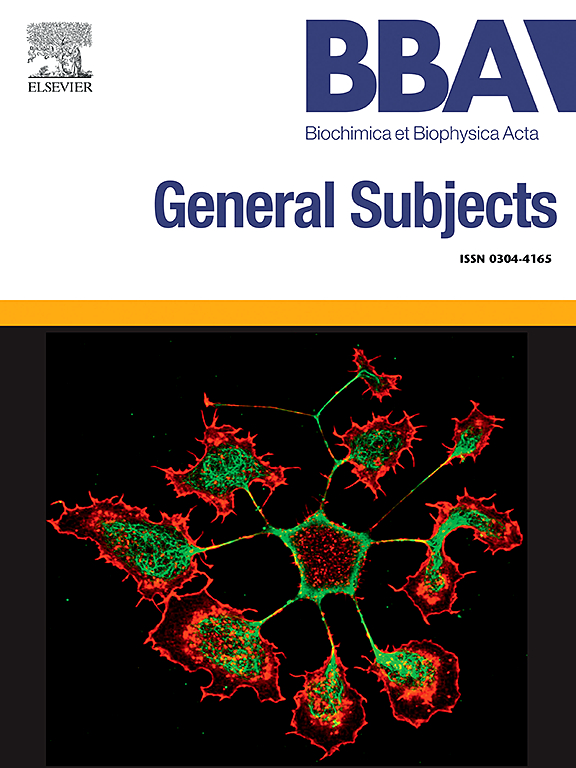USP33-mediated stabilization of c-Myc drives glycolytic reprogramming and promotes ovarian cancer progression
IF 2.2
3区 生物学
Q3 BIOCHEMISTRY & MOLECULAR BIOLOGY
Biochimica et biophysica acta. General subjects
Pub Date : 2025-06-16
DOI:10.1016/j.bbagen.2025.130830
引用次数: 0
Abstract
Ovarian cancer (OC) is one of the most lethal gynecological malignancies, characterized by late-stage presentation, high recurrence rates, and a lack of effective early diagnostic markers. Recent evidence suggests that deubiquitinating enzymes (DUBs) play pivotal roles in tumor development and metabolic reprogramming. Here, we identify and characterize the function of the deubiquitinase USP33 in regulating c-Myc stability and glycolytic metabolism in OC. Through quantitative PCR (qPCR) and Western blot analyses, we show that USP33 is significantly upregulated in both OC tissues and cell lines compared to normal controls. Functional assays reveal that USP33 knockdown markedly inhibits cell proliferation, migration, and invasion while promoting apoptosis. Metabolically, USP33 silencing reduces glucose uptake, lactate production, and the extracellular acidification rate, consistent with downregulation of key glycolytic enzymes (LDHA, GLUT1, and PKM2). Mechanistically, co-immunoprecipitation and ubiquitination assays demonstrate that USP33 interacts with and deubiquitinates c-Myc at K48-linked chains, thereby stabilizing c-Myc protein levels and enhancing its transcriptional activity. Moreover, c-Myc overexpression rescues the inhibitory effects of USP33 knockdown on both glycolysis and malignant phenotypes. Clinically, high USP33 expression correlates with poor prognosis, suggesting that the USP33–c-Myc axis may serve as both a prognostic biomarker and a potential therapeutic target. Taken together, our findings highlight a critical role for USP33 in OC pathogenesis by mediating c-Myc-driven glycolytic reprogramming, and they provide new insights for developing targeted treatment strategies aimed at disrupting this pathway.
usp33介导的c-Myc稳定驱动糖酵解重编程并促进卵巢癌进展。
卵巢癌(OC)是最致命的妇科恶性肿瘤之一,其特点是晚期出现,复发率高,缺乏有效的早期诊断标志物。最近的证据表明,去泛素化酶(DUBs)在肿瘤的发展和代谢重编程中起着关键作用。在这里,我们确定并表征了去泛素酶USP33在OC中调节c-Myc稳定性和糖酵解代谢的功能。通过定量PCR (qPCR)和Western blot分析,我们发现与正常对照相比,USP33在OC组织和细胞系中均显著上调。功能分析显示,USP33敲低显著抑制细胞增殖、迁移和侵袭,同时促进细胞凋亡。在代谢方面,USP33沉默降低了葡萄糖摄取、乳酸生成和细胞外酸化速率,这与关键糖酵解酶(LDHA、GLUT1和PKM2)的下调一致。机制上,共免疫沉淀和泛素化实验表明,USP33与k48链上的c-Myc相互作用并使其去泛素化,从而稳定c-Myc蛋白水平并增强其转录活性。此外,c-Myc过表达恢复了USP33敲低对糖酵解和恶性表型的抑制作用。临床上,USP33高表达与不良预后相关,提示USP33-c- myc轴既可作为预后生物标志物,也可作为潜在的治疗靶点。综上所述,我们的研究结果强调了USP33通过介导c- myc驱动的糖酵解重编程在OC发病机制中的关键作用,并为开发旨在破坏这一途径的靶向治疗策略提供了新的见解。
本文章由计算机程序翻译,如有差异,请以英文原文为准。
求助全文
约1分钟内获得全文
求助全文
来源期刊

Biochimica et biophysica acta. General subjects
生物-生化与分子生物学
CiteScore
6.40
自引率
0.00%
发文量
139
审稿时长
30 days
期刊介绍:
BBA General Subjects accepts for submission either original, hypothesis-driven studies or reviews covering subjects in biochemistry and biophysics that are considered to have general interest for a wide audience. Manuscripts with interdisciplinary approaches are especially encouraged.
 求助内容:
求助内容: 应助结果提醒方式:
应助结果提醒方式:


